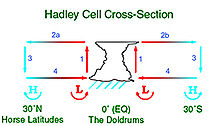Centers of action
Centers of actionare extensive and almost stationaryloworhigh pressureareas which control the movement of atmospheric disturbances over a large area.[1][2][3][4]This does not mean that the position of the center is constant over a specific area but that the monthly atmospheric pressure corresponds to a high or a low pressure.[5][6]
The French meteorologistLéon Teisserenc de Bortwas the first in 1881 to apply this term to maxima and minima of pressure on daily charts. The main centers of action in the Northern Hemisphere are theIcelandic Low,theAleutian Low,theAzores/Bermuda High,thePacific High,theSiberian High(in winter), and theAsiatic Low(in summer).[7]SirGilbert Walkerused the same term to relate meteorological elements in a region to weather in the following season in other regions for theSouthern Oscillation.[7]
Causes
[edit]
In the region called theHorse latitudes,between 30 and 35 degrees of latitude North or South, there is a series of semi-permanent anticyclones on the downward side of theHadley cellof the generalatmospheric circulation.The thermal contrasts over oceanic waters leads to the formation of these centers of action as a direct convective circulation is established between the equator and higher latitudes in a very weakCoriolis forcezone.[8]The Azores/Bermuda High is found in this zone.
Similarly, low pressure areas are formed in the oceanic circulation near the Polar regions were sea water is much warmer than the land. Such centers are theIcelandic Low,theAleutian Lowand numerous lows near the coast ofAntarctica.[9]
Finally, in both hemispheres, there are centers of action inland in large continental zones where cold or warm air can be trapped by surrounding mountainous zones or high contrast or temperature by surrounding seas. This is the case forSiberiawhere the temperature is very cold in winter forming theSiberian High,or very hot in summer to give athermal lowin summer. Antarctica is so cold in all seasons that it has a permanent anticyclone at its center.
Climatology
[edit]
The intensity of these systems vary during the year depending on the temperature of water and air. The action centers falter when the temperature contrasts decrease and conversely, they reinforce when these increases. Their position also varies, always following the maximum contrast. For example, the Azores anticyclone moves between theAzoresandBermuda,according to the position of theGulf Streamand the difference in warming between the Poles and the equator.[9]
The distribution of the action centers in theSouthern Hemispherechanges far less than in theNorthern Hemisphereduring the year because the landmass in that hemisphere is relatively small. Apart from a thermal anticyclone over Australia during the southern winter, the centers of action are fairly stable over the oceans. The southern parts of the Atlantic, Indian, and Pacific oceans have three anticyclones over theHorse latitudes.Further South, a fairly continuous series of low pressure areas cover the ocean near Antarctica during the whole year and does the Antarctica High over the continent.[9]
References
[edit]- ^World Meteorological Organization."Center of action".Eumetcal. Archived fromthe originalon 2016-03-03.RetrievedFebruary 27,2016.
- ^Hameed, Sultan; Piontkovski, Sergey (2004-05-04). "The dominant influence of the Icelandic Low on the position of the Gulf Stream northwall".Geophysical Research Letters.31(9): n/a.Bibcode:2004GeoRL..31.9303H.doi:10.1029/2004gl019561.ISSN0094-8276.
- ^Osman, Mahmoud; Zaitchik, Benjamin; Badr, Hamada; Hameed, Sultan (2020)."North Atlantic centers of action and seasonal to subseasonal temperature variability in Europe and eastern North America".International Journal of Climatology.41.doi:10.1002/joc.6806.ISSN1097-0088.S2CID225429315.
- ^Riaz, Syed M. F.; Iqbal, M. J.; Hameed, Sultan (2017-01-01)."Impact of the North Atlantic Oscillation on winter climate of Germany".Tellus A: Dynamic Meteorology and Oceanography.69(1): 1406263.Bibcode:2017TellA..6906263R.doi:10.1080/16000870.2017.1406263.S2CID134341376.
- ^World Meteorological Organization."Semi-permanent anticyclone".Eumetcal. Archived fromthe originalon October 15, 2013.RetrievedFebruary 27,2016.
- ^World Meteorological Organization."Semi-permanent depression".Eumetcal. Archived fromthe originalon 2016-03-03.RetrievedFebruary 27,2016.
- ^ab"Center of action".Glossary.American Meteorological Society.RetrievedFebruary 27,2016.
- ^Richard, Leduc; Raymond, Gervais (1985).Connaître la météorologie(in French). Montréal: Presses de l'Université du Québec.p. 72 (section 3.6 "Les grands traits de la circulation générale" ).ISBN2-7605-0365-8.RetrievedFebruary 27,2016..
- ^abc"Centre d'action".Glossaire la météo(in French).Météo-France.RetrievedFebruary 27,2016..

